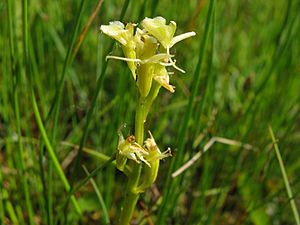Fen orchid facts for kids
Quick facts for kids Fen orchid |
|
|---|---|
 |
|
| Scientific classification | |
| Genus: |
Liparis (plant)
|
| Species: |
loeselii
|
The fen orchid (Liparis loeselii) is a special type of orchid. You might also hear it called the yellow widelip orchid or bog twayblade. This plant has pretty yellow flowers and shiny yellow-green leaves.
Fen orchids are found in many parts of the world. They grow naturally in Europe, northern Asia, the eastern United States, and eastern Canada.
Contents
What is a Fen Orchid?
The fen orchid is a small plant that loves wet places. It's part of the huge orchid family, which has many different kinds of flowers. This particular orchid is known for its bright yellow flowers. They are usually small and grow in a cluster on a stem. The leaves are glossy and have a fresh, green-yellow color.
Where Does It Grow?
Fen orchids are quite picky about where they live. They need very specific wet environments. You can find them in:
- Fens: These are wetlands that get their water from groundwater. This water is rich in minerals, which the fen orchid needs.
- Bogs: These are also wetlands, but they get most of their water from rain. Bogs are usually more acidic than fens.
- Dune slacks: These are wet, low areas found between sand dunes, often near the coast. They can be quite damp and provide the right conditions for the orchid.
Because they need these special habitats, fen orchids are often rare. Protecting these wetlands helps to keep these beautiful plants safe.
Different Kinds of Fen Orchids
Even though it's one species, the fen orchid has a few different forms. These are called subspecies. They are mostly found in different parts of the world:
- Liparis loeselii subsp. loeselii: This is the most common type. It grows in Europe, Russia, Canada, and the United States.
- Liparis loeselii subsp. orientalis: This one is found in the Altay region of Russia.
- Liparis loeselii subsp. sachalinensis: You can find this subspecies on Sakhalin Island in Russia.
These subspecies are very similar but have small differences that scientists use to tell them apart.
Images for kids
See also
 In Spanish: Liparis loeselii para niños
In Spanish: Liparis loeselii para niños


